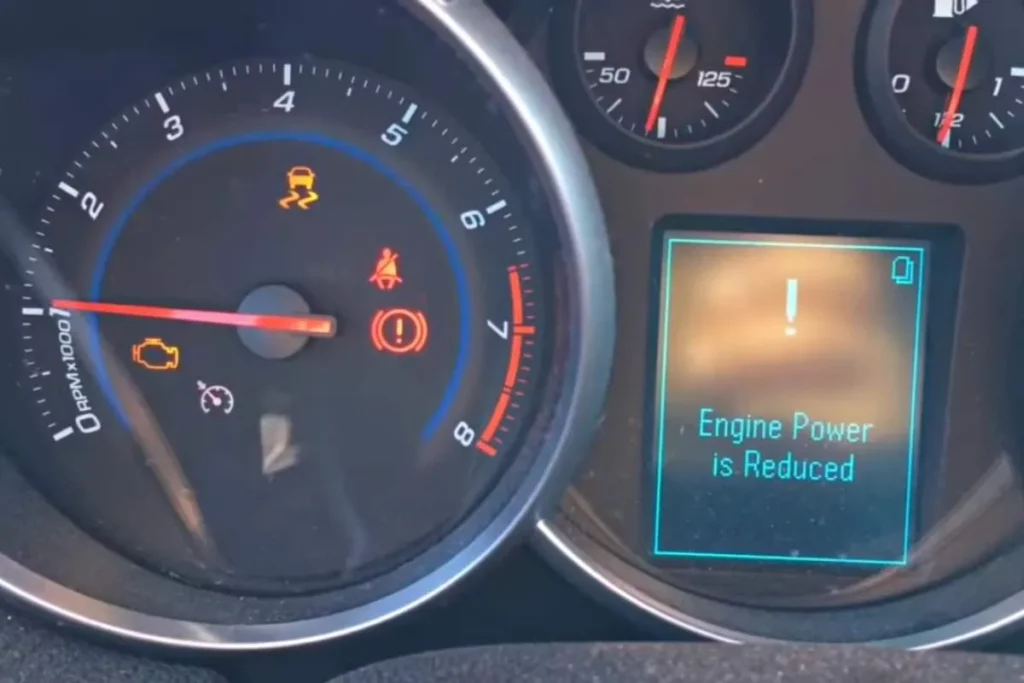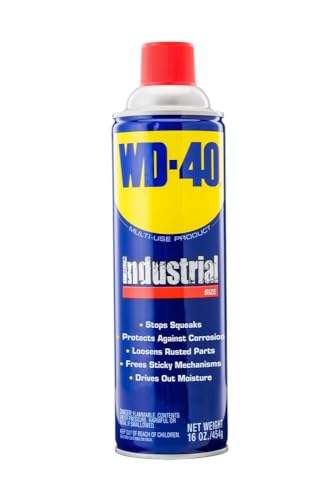As much as advances in electronics have helped make today’s cars comfortable and safe, they also introduced modes of failure that can bring a car to a standstill.
The reduced power traction fault is one such mode of failure in Chevy Colorado.
This one’s a little tricky as there are several reasons for it.
Stay with me if you want to learn more about the problem’s manifestation and the possible solutions to resolve it.

Major Causes Of Reduced Power, Traction Fault
Reduced power traction fault mostly occurs due to a problem with
- A bad ground (rusty connections)
- A loose hose under the intake manifold.
- 12V battery issue.
- Sometimes bad quality fuel can also cause this problem.
- Faulty sensors, i.e., the throttle position sensor, wheel speed sensors,
- Dirty throttle body.
- The Traction Control System (TCS)
- Power Control Module (PCM)
The traction control system, the power control module, and the electronic throttle control use inputs from each other to monitor and control vehicle performance.
In the section below, I will capture the symptoms that indicate an issue that could result in a reduced power traction fault.
However, having an OBD tool is a huge benefit, and you should definitely consider having one.
OBD2 Scanner
FOXWELL NT301 OBD2 Scanner
The NT301 obd2 scanner enables you to read DTCs, access to e-missions readiness status, turn off CEL(check engine light) or MIL, reset monitor, read live data and retrieve VIN of your vehicle.
Check PriceMeaning of OBD Codes Related to Reduced Power
- P1390 to P1399 relate to Wheel Speed Sensors
- P0120 to P0124 relates to the Throttle Position Sensor.
- P0220 to P0224 relate to Accelerator Pedal Position (Throttle Position) Sensor.
- P1120 to P1122 relates to Throttle Position Sensor Circuit.
- P1510 to P1526 relate to Electronic Throttle System.
Look, Listen, Feel.
Good drivers have a keen sense of how their car behaves and immediately tell when something is amiss.
In case of a faulty traction control system, look for the following more common symptoms, which have been grouped under the major causes discussed above.
First Things First Before Spending $$$ On The Diagnosis And Repair
- Try using fuel with higher octane, preferably mid-grade.
- Clean all the connections of the sensors involved with WD-40
- Disconnect the battery for about 15 minutes and reconnect
- Check for any loose hose on the intake manifold
Traction Control System
- At the onset of skidding, the TCS uses the ABS to selectively apply brakes to each wheel based on the rotational speed measured by sensors. A faulty TCS may exhibit inconsistent braking, sometimes more aggressively than warranted, causing tire lock or otherwise not aggressively enough.
- Traction control will not engage or disengage, either due to dirt, grime, or some issue with the controller itself.
Electronic Throttle Control
- Your car will behave as if you are sequentially applying and releasing pressure on the accelerator in quick succession.
- The car will either be sluggish to accelerate or, in some cases, not drive at all.
- The engine starts and runs for a bit but then fails. Although not recommended, you can keep it running by putting slight pressure on the pedal, but as soon as you take the foot off, it dies.
- The car engine will rev up and down, especially at idle.
- Poor fuel economy.
Reasons for TCS Malfunction
In this section, we list the major components affecting how your Chevy Colorado’s traction control behaves.
- Wheel Sensors on each wheel are responsible for monitoring the rotational speed of tires. These sensors provide input to the TCS. Remember that the system detects skids by comparing the rotational speed of tires. A faulty wheel sensor can intermittently provide incorrect information to TCS to cause it to behave erratically.
- If your truck’s steering rack is not up to the mark, it will be harder for you to steer on a rough road which can cause the TCS to malfunction.
- An issue with the electronic throttle control.
Reason for ETC Malfunction
The ETC can have functional issues because of the following.
- The throttle position sensor is notorious in Chevy Colorado; thus, the ETC malfunctions, no thanks to that.
- Accelerator pedal or the allied sensor.
- Incorrect data from the TCS triggers reduced power.
- Loose intake manifold hose.
The Chevy Colorado Reduced Power Traction Fix
Based on the problem, and most of the time, a bit tricky to identify, the solution can range from a simple WD-40 spray or as involved as changing the throttle position sensor.
The Quickie
Drivers of Chevy Colorado have reported having sorted the issue by pulling over to the side of the road or a parking area and turning off the engine for about half an hour, which will temporarily get you going.
Some even disconnected the battery terminals. The result is to reset whichever control unit or sensor is misbehaving. Sometimes it works, and then you no longer have the problem.
On the contrary, this might resolve the issue but only temporarily, and the issue will most likely keep on popping up until properly diagnosed and fixed.
The Wheels Are Skidding, Or Are They
Part of the function of the TCS is to provide input to the throttle control to cut down power to avoid a skid.
It involves monitoring and comparing each tire’s rotational speed by using sensors mounted on each wheel to determine if a tire is skidding or locking.
The throttle control is then alerted to cut down on power to stabilize the vehicle. A faulty wheel sensor can provide incorrect input and also result in a power cut even under normal driving conditions.
One such sensor is the wheel sensor. To determine if the problem is due to the wheel sensor, you need to have it scanned by a professional scan tool.
Unfortunately, on Chevy Colorado, the wheel sensors are part of the wheel hub, so this needs to be replaced. I would rate it as a difficult DIY, so it is better to have a qualified technician handle it.
For the more adventurous, I have a link below in the references on how to DIY.
The average cost of replacement, including labor, ranges between $400 to $450, with the cost of parts about $265. The cost of scanning may be on top of this.
Control The Controller
In some cases, the traction control module (TCM) itself can malfunction and generate incorrect output that may illuminate the traction control light. It will then result in the system activating the reduced power mode.
Have a qualified technician diagnose if the controller is causing havoc.
Before accessing the TCM, you would have to do the following steps.
- Disconnect the battery.
- Locate where the controller is and unplug the connections.
- Clean them with something like WD-40, dry them, insert them back and see if the issue gets resolved.
- As a next step, have the controller reprogrammed. Sometimes this will flush out erroneous data, and the issue will be resolved.
Replacing the controller is a relatively simple DIY, just remove the controller from its assembly and unplug the wires from the old controller and plug them back into the new one.
I have included a YouTube video in the references to help you along.
To Throttle Or Not To Throttle
Finally, one of the most likely causes of the reduced power traction fault on your Chevy Colorado could be the throttle body or the throttle position sensor (TPS).
If you are out of luck, the throttle body itself can be faulty or seem faulty. So before jumping to change it, have the throttle body cleaned, and if that does not solve the issue, have the powertrain control module reprogrammed.
It is recommended to have the accelerator pedal and the accelerator pedal position sensor also diagnosed to ensure that these are not faulty components.
The throttle position sensor measures the extent of the opening of the throttle valve and controls the amount of air that needs to flow into the engine intake manifold.
A faulty sensor will result in reduced power indication along with the traction control light being lit.
If the sensor is suspected, and you do not have a proper scanner, it is best to have it handled by a qualified technician because other faulty sensors can behave like faulty TPS.
The sensor is located in the intake manifold and is relatively easy to access. You will need a ratchet, socket set, extension, and a flat screwdriver.
Poor connection or rusting can be an issue, so check for that before changing anything. Sometimes the wiring or the harness could be bad, so check for that too.
Once it is all said and done, and if the faulty sensor caused a check engine light to be lit, you would finally be able to bid farewell to that pesky check engine light.
Conclusion
In this post, I have tried to answer the major reasons that may cause reduced power traction faults on your Chevy Colorado.
By now, you may have a very clear idea of what we are dealing with. It is a complicated fault to trace and resolve. Blogs are full of horror stories of the so-called qualified technicians making all the wrong replacements.
A piece of advice.
- Your vehicle is an integral part of your life. Love it and take care of it. A well-maintained car is less likely to give you unexpected complicated headaches.
- Always go for genuine parts when there is a need for replacement.
Sources
https://www.fixya.com/cars/t18421877-reduced_power_traction_fault_mean
https://www.yourmechanic.com/article/symptoms-of-a-bad-or-failing-traction-control-switch
https://www.yourmechanic.com/article/how-to-replace-a-traction-control-module-by-ronny-brown
https://www.yourmechanic.com/question/both-my-engine-power-reduced-and-stability-track-light-came-on-should-i-wait-till-tomorrow-and-see-if-it-happens-again-or-take-it-by-sarah-l#:~:text=Hi%20There%2C%20The%20Stability%20Track,to%20keep%20the%20passengers%20safe.
https://www.youtube.com/watch?v=Ik38rwvrzCw (Chevy Colorado TCM swap)
https://www.youtube.com/watch?v=S0temq1xiQg (Chevy Colorado, How to replace the ABS Sensor and Wheel Hub)
https://www.youtube.com/watch?v=8oilL8HmQTs (Chevy Colorado, How to Replace Throttle Position Sensor)
https://repairpal.com/estimator/chevrolet/colorado/wheel-hub-assembly-replacement-cost#:~:text=Chevrolet%20Colorado%20Wheel%20Hub%20Assembly%20Replacement%20Cost%20Estimate&text=The%20average%20cost%20for%20a,priced%20between%20%24266%20and%20%24269.
https://repairpal.com/reduced-power-and-check-engine-light-586
https://repairpal.com/throttle-position-sensor
https://repairpal.com/estimator/chevrolet/colorado/throttle-body-replacement-cost#:~:text=The%20average%20cost%20for%20a,model%20year%20or%20unique%20location.

